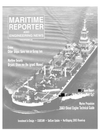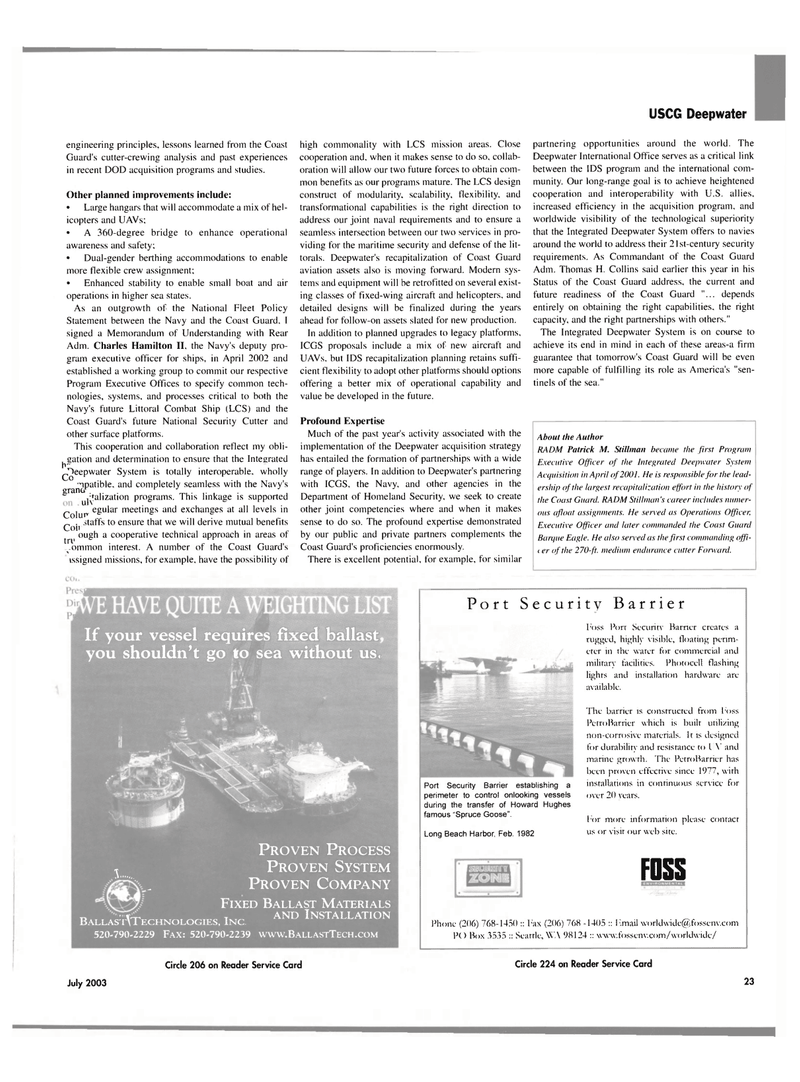
Page 21: of Maritime Reporter Magazine (July 2003)
Read this page in Pdf, Flash or Html5 edition of July 2003 Maritime Reporter Magazine
USCG Deepwater engineering principles, lessons learned from the Coast
Guard's cutter-crewing analysis and past experiences in recent DOD acquisition programs and studies.
Other planned improvements include: • Large hangars that will accommodate a mix of hel- icopters and UAVs; • A 360-degree bridge to enhance operational awareness and safety; • Dual-gender berthing accommodations to enable more flexible crew assignment; • Enhanced stability to enable small boat and air operations in higher sea states.
As an outgrowth of the National Fleet Policy
Statement between the Navy and the Coast Guard. 1 signed a Memorandum of Understanding with Rear
Adm. Charles Hamilton II, the Navy's deputy pro- gram executive officer for ships, in April 2002 and established a working group to commit our respective
Program Executive Offices to specify common tech- nologies, systems, and processes critical to both the
Navy's future Littoral Combat Ship (LCS) and the
Coast Guard's future National Security Cutter and other surface platforms.
This cooperation and collaboration reflect my obli- , gation and determination to ensure that the Integrated h'- ^eepwater System is totally interoperable, wholly •npatible. and completely seamless with the Navy's ^"^alization programs. This linkage is supported
Colur- e?u'ar meetings and exchanges at all levels in _ . staffs to ensure that we will derive mutual benefits
Con tri t ough a cooperative technical approach in areas of ^ ommon interest. A number of the Coast Guard's issigned missions, for example, have the possibility of high commonality with LCS mission areas. Close cooperation and, when it makes sense to do so, collab- oration will allow our two future forces to obtain com- mon benefits as our programs mature. The LCS design construct of modularity, scalability, flexibility, and transformational capabilities is the right direction to address our joint naval requirements and to ensure a seamless intersection between our two services in pro- viding for the maritime security and defense of the lit- torals. Deepwater's recapitalization of Coast Guard aviation assets also is moving forward. Modern sys- tems and equipment will be retrofitted on several exist- ing classes of fixed-wing aircraft and helicopters, and detailed designs will be finalized during the years ahead for follow-on assets slated for new production.
In addition to planned upgrades to legacy platforms.
ICGS proposals include a mix of new aircraft and
UAVs. but IDS recapitalization planning retains suffi- cient flexibility to adopt other platforms should options offering a better mix of operational capability and value be developed in the future.
Profound Expertise
Much of the past year's activity associated with the implementation of the Deepwater acquisition strategy has entailed the formation of partnerships with a wide range of players. In addition to Deepwater's partnering with ICGS, the Navy, and other agencies in the
Department of Homeland Security, we seek to create other joint competencies where and when it makes sense to do so. The profound expertise demonstrated by our public and private partners complements the
Coast Guard's proficiencies enormously.
There is excellent potential, for example, for similar partnering opportunities around the world. The
Deepwater International Office serves as a critical link between the IDS program and the international com- munity. Our long-range goal is to achieve heightened cooperation and interoperability with U.S. allies, increased efficiency in the acquisition program, and worldwide visibility of the technological superiority that the Integrated Deepwater System offers to navies around the world to address their 21 st-century security requirements. As Commandant of the Coast Guard
Adm. Thomas H. Collins said earlier this year in his
Status of the Coast Guard address, the current and future readiness of the Coast Guard "... depends entirely on obtaining the right capabilities, the right capacity, and the right partnerships with others."
The Integrated Deepwater System is on course to achieve its end in mind in each of these areas-a firm guarantee that tomorrow's Coast Guard will be even more capable of fulfilling its role as America's "sen- tinels of the sea."
About the Author
RADM Patrick M. Still man became the first Program
Executive Officer of the Integrated Deepwater System
Acquisition in April of2001. He is responsible for the lead- ership of the largest recapitalization effort in the history o f the Coast Guard. RADM Stillman's career includes numer- ous afloat assignments. He served as Operations Officer,
Executive Officer and later commanded the Coast Guard
Barque Eagle. He also served as the first commanding offi- cer of the 270-ft. medium endurance cutter Forward.
If your vessel requires fixed ballast you shouldn't go to sea without us,
PROVEN PROCESS ^ PROVEN SYSTEM - PROVEN COMPANY
FIXED BALLAST MATERIALS
BALLAS;R\TECHNOLOGIES, INC. AND INSTALLATION 520-790-2229 FAX: 520-790-2239 WWW.BALLASTTEGH.COM
Port Security Barrier
Port Security Barrier establishing a perimeter to control onlooking vessels during the transfer of Howard Hughes famous "Spruce Goose".
Long Beach Harbor, Feb. 1982
Foss Port Security Barrier creates a rugged, highly visible, floating perim- eter in the water for commercial and military facilities. Photocell flashing lights and installation hardware are available.
The barrier is constructed from Foss
PctroBarricr which is built utilizing non-corrosive materials. It is designed for durability and resistance to IV and marine growth. The PctroBarricr has been proven effective since 1977, with installations in continuous service for (jver 20 years.
For more information please contact us or visit our web site.
FDSS
Phone (206) 768-1450 :: Fax (206) 768-1405 :: Email [email protected]
PO Box 3535 :: Seattle, W'A 98124 :: wAvw.fossenv.com/worldwide/
Circle 206 on Reader Service Card Circle 224 on Reader Service Card
July 2003 23

 20
20

 22
22
